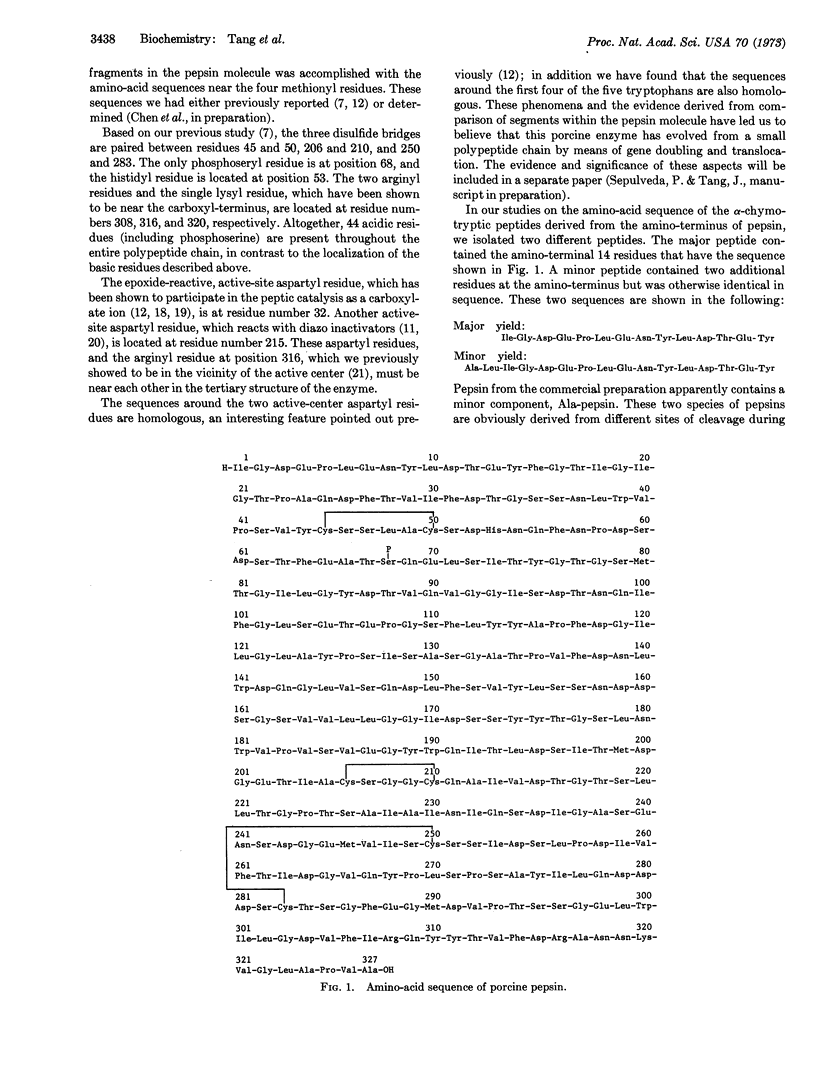Abstract
As the culmination of several years of experiments, we propose a complete amino-acid sequence for porcine pepsin, an enzyme containing 327 amino-acid residues in a single polypeptide chain. In the sequence determination, the enzyme was treated with cyanogen bromide. Five resulting fragments were purified. The amino-acid sequence of four of the fragments accounted for 290 residues. Because the structure of a 37-residue carboxyl-terminal fragment was already known, it was not studied. The alignment of these fragments was determined from the sequence of methionyl-peptides we had previously reported. We also discovered the locations of activesite aspartyl residues, as well as the pairing of the three disulfide bridges. A minor component of commercial crystalline pepsin was found to contain two extra amino-acid residues, Ala-Leu-, at the amino-terminus of the molecule. This minor component was apparently derived from a different site of cleavage during the activation of porcine pepsinogen.
Keywords: protein, cyanogen bromide, active site
Full text
PDF


Selected References
These references are in PubMed. This may not be the complete list of references from this article.
- Bayliss R. S., Knowles J. R., Wybrandt G. B. An aspartic acid residue at the active site of pepsin. The isolation and sequence of the heptapeptide. Biochem J. 1969 Jun;113(2):377–386. doi: 10.1042/bj1130377. [DOI] [PMC free article] [PubMed] [Google Scholar]
- Chen K. C., Tang J. Amino acid sequence around the epoxide-reactive residues in pepsin. J Biol Chem. 1972 Apr 25;247(8):2566–2574. [PubMed] [Google Scholar]
- Dopheide T. A., Jones W. M. Studies on the tryptophan residues in porcine pepsin. J Biol Chem. 1968 Jul 25;243(14):3906–3911. [PubMed] [Google Scholar]
- Dopheide T. A., Moore S., Stein W. H. The carboxyl-terminal sequence of porcine pepsin. J Biol Chem. 1967 Apr 25;242(8):1833–1837. [PubMed] [Google Scholar]
- Hartsuck J. A., Tang J. The carboxylate ion in the active center of pepsin. J Biol Chem. 1972 Apr 25;247(8):2575–2580. [PubMed] [Google Scholar]
- Huang W. Y., Tang J. Modification of an arginyl residue in pepsin by 2,3-butanedione. J Biol Chem. 1972 May 10;247(9):2704–2710. [PubMed] [Google Scholar]
- Kostka V., Morávek L., Sorm F. Amino acid sequence of C-terminal fragment of hog pepsin. Eur J Biochem. 1970 Apr;13(3):447–454. doi: 10.1111/j.1432-1033.1970.tb00948.x. [DOI] [PubMed] [Google Scholar]
- Matveeva R. A., Krivtsov V. F., Stepanov V. M. Streoenie peptidov, poluchennykh iz tripsinovogo gidrolizata svinogo pepsina. Biokhimiia. 1968 Jan-Feb;33(1):167–174. [PubMed] [Google Scholar]
- Perham R. N., Jones G. M. The determination of the order of lysine-containing tryptic peptides of proteins by diagonal paper electrophoresis. A carboxyl-terminal sequence for pepsin. Eur J Biochem. 1967 Jul;2(1):84–89. doi: 10.1111/j.1432-1033.1967.tb00110.x. [DOI] [PubMed] [Google Scholar]
- Rajagopalan T. G., Moore S., Stein W. H. Pepsin from pepsinogen. Preparation and properties. J Biol Chem. 1966 Nov 10;241(21):4940–4950. [PubMed] [Google Scholar]
- STEERS E., Jr, CRAVEN G. R., ANFINSEN C. B., BETHUNE J. L. EVIDENCE FOR NONIDENTICAL CHAINS IN THE BETA-GALACTOSIDASE OF ESCHERICHIA COLI K12. J Biol Chem. 1965 Jun;240:2478–2484. [PubMed] [Google Scholar]
- Slobin L. I., Singer S. J. The specific cleavage of immunoglobulin polypeptide chains at cysteinyl residues. J Biol Chem. 1968 Apr 25;243(8):1777–1786. [PubMed] [Google Scholar]
- Stepanov V. M., Timokhina E. A., Baratova L. A., Belyanova L. P., Korzhenko V. P., Zhukova I. G. On the activation of pepsinogen. Biochem Biophys Res Commun. 1971 Dec 17;45(6):1482–1487. doi: 10.1016/0006-291x(71)90187-2. [DOI] [PubMed] [Google Scholar]
- Tang J. Amino acid sequence near the amino terminus of porcine pepsin. Biochem Biophys Res Commun. 1970 Nov 9;41(3):697–703. doi: 10.1016/0006-291x(70)90069-0. [DOI] [PubMed] [Google Scholar]
- Tang J., Hartley B. S. Amino acid sequences around the disulphide bridges and methionine residues of porcine pepsin. Biochem J. 1970 Jul;118(4):611–623. doi: 10.1042/bj1180611. [DOI] [PMC free article] [PubMed] [Google Scholar]
- Tang J. Specific and irreversible inactivation of pepsin by substrate-like epoxides. J Biol Chem. 1971 Jul 25;246(14):4510–4517. [PubMed] [Google Scholar]
- Vakhitova E. A., Amirkhanian M. M., Stepanov V. M. Fosfopeptidnyi fragment pepsina svin'i. Biokhimiia. 1970 Nov-Dec;35(6):1164–1169. [PubMed] [Google Scholar]
- Valiulis R. A., Stepanov V. M. Peptidy, obrazuishchiesia pri khimotripsinovom gidrolize N-kontsevogo fragmenta pepsina. Biokhimiia. 1971 Mar-Apr;36(2):358–362. [PubMed] [Google Scholar]
- Vasenev V. I., Kuznetsov Iu S., Stepanov V. M. Triptofansoderzhashchie peptidy pepsina. Biokhimiia. 1970 Jul-Aug;35(4):787–796. [PubMed] [Google Scholar]
- al-Janabi J., Hartsuck J. A., Tang J. Kinetics and mechanism of pepsinogen activation. J Biol Chem. 1972 Jul 25;247(14):4628–4632. [PubMed] [Google Scholar]


